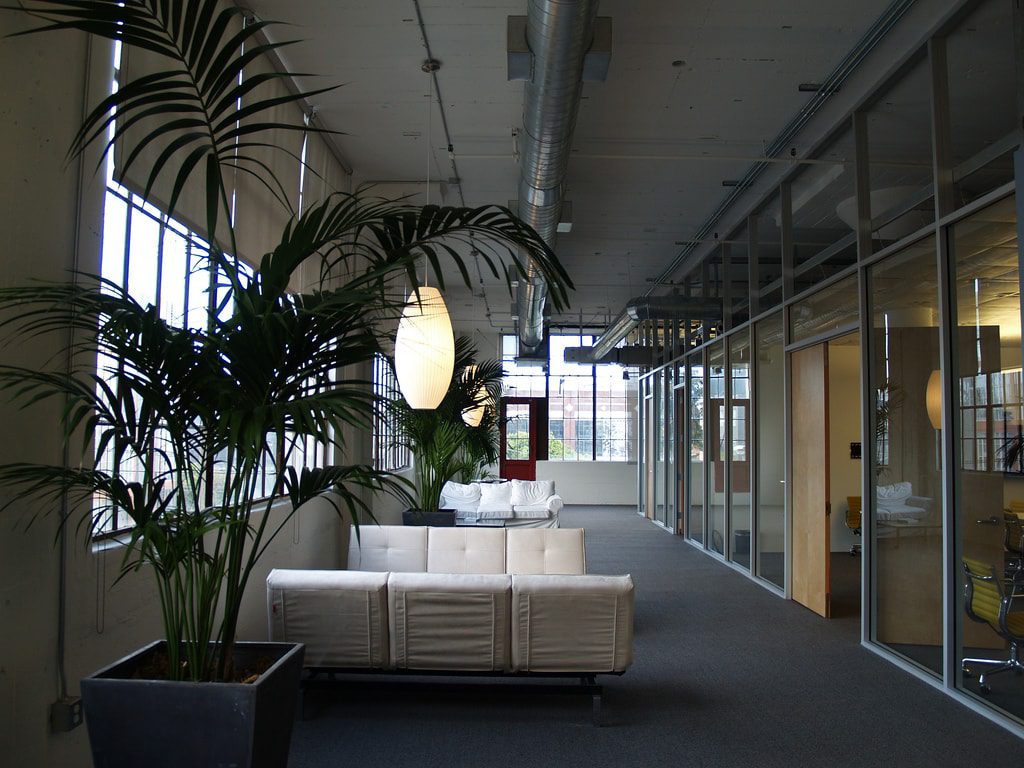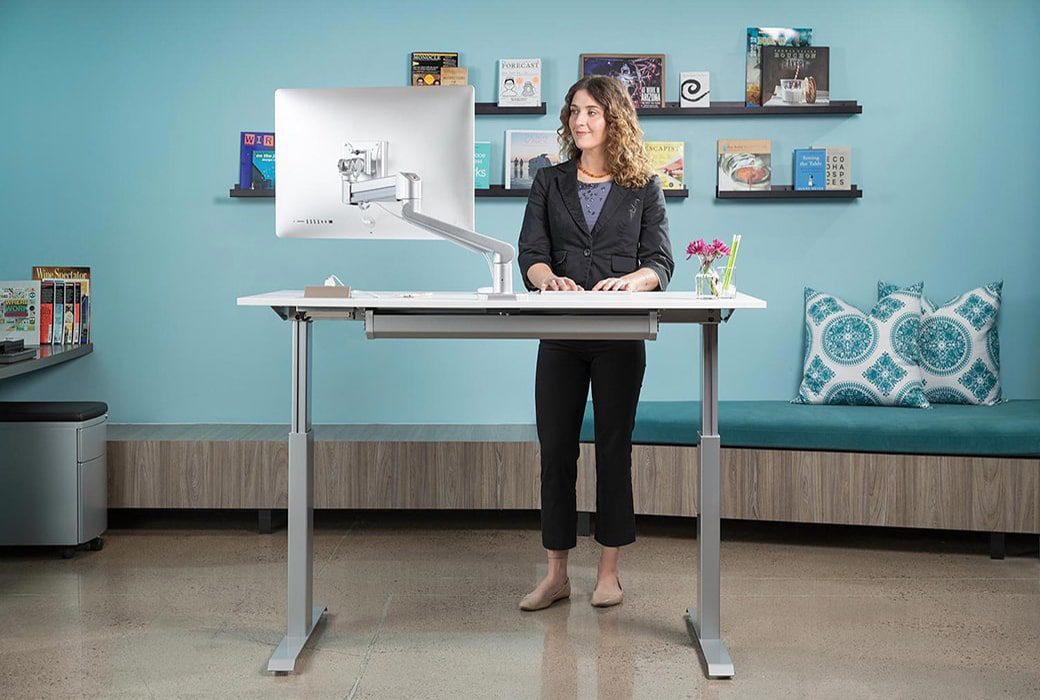There is no denying that working in an office, especially cubicles with no windows to the outside, can be difficult at best and downright harmful at their worst. Ask anyone who has had surgery for carpal tunnel, tendonitis, or suffers from the First Year 15 (when people tend to put on 15 pounds during their first year at a desk job)
Are there ways that you can make your office healthier? We mean healthier for the people who work there, not the company’s bottom line, of course.
You might not think something as simple as changing your desk or adding plants can help but studies show that small steps add up to big gains.
Share this article with your colleges and perhaps CC your boss. These tips for a healthy office environment can make for happier, healthier employees, which hugely influences the bottom line.
#1 Problem: Lack of Exposure to Natural Light Leads to Health Problems and Mental Issues
Solution: Install Light Boxes or Lamps that Mimic Natural Light
If you have ever worked in a windowless cubicle or a workspace that only looks out into hallways and wondered why you don’t sleep well at night (and therefore don’t perform as well during the day) you can blame it all on your circadian rhythm.
Nearly every living thing on the planet operates on natural daylight. Our circadian rhythm tells humans to wake up when it’s light outside and sleep within hours after it’s dark, as well as regulating our body temperature, the release of hormones, even the rate of our metabolism.
Disruption in our circadian rhythm leads to poor sleep cycles, seasonal affective disorder (known as SAD), higher rates of depression and possibly even diabetes!
A 2014 study compared 27 workers who worked in offices with no windows with 22 workers who had exposure to natural light. They asked subjects to fill out questionnaires regarding their sleep patterns, quality of sleep, levels of depression, and physical activity. All of the workers who received no natural light noted that they received less sleep, felt sad more often, and got less physical activity outside of work than those who had access to natural daylight.
While not every company can afford to change buildings or remodel offices, the addition of inexpensive light boxes or sun lamps which mimic natural daylight can improve the mood and physical well-being of employees by stimulating their natural circadian rhythm.
#2 Problem: Employees Suffer from Weight Gain, Job Dissatisfaction, Low Productivity
Solution: Standing or Treadmill Desk

Fifty years ago, or more, the old joke was that the only gain secretaries would get was the old “Secretary Spread” (referring to weight gain on the thighs and bottom from long hours of sitting)
This “joke” is now applicable to almost every office worker in America, with many workers believing that they need to eat lunch at their desk, leave only for necessary restroom breaks, and work overtime to either keep their job or to maintain a good reputation.
Sitting for hours at a desk often leads to weight gain, which causes numerous health issues, job burnout, depression, and does the opposite of what employers really want; increase productivity.
Studies have found that adding an adjustable desk, which allows users to stand while using their computers or phones or a “treadmill” desk, which allows users to walk (very slowly, of course) while using their office equipment can lead to tremendous and positive changes. Every healthy office tip article includes adjustable or treadmill desks.
#3 Problem: Employees That are Stressed Out Cost Companies Thousands
Solution: Offer Stress Relief in Various Manners
No matter how simple someone’s job might be, you can guarantee it will have some sort of stress attached to it. Whether it’s difficult to get to work on time due to traffic, answering for your employee’s screw-ups, or trying to make daycare arrangements for a sick child, stress comes to almost all employees in one form or another.
Most employers recognize that when stress hits a certain point, it means downtime for an employee, which can add up to thousands of dollars in lost productivity.
Employers can help to relieve stress by implementing several methods, including:
- Creating more comfortable break rooms where employees can truly relax, not simply cafeteria-style plastic chairs.
- Discuss the benefits of employees taking lunch breaks and afternoon breaks away from their cubicle.
- Suggest that employees form walking groups or take turns fetching Starbucks orders or lunch orders by walking, rather than rely on delivery service.
- If possible, create a few “quiet rooms” for massage therapy where employees can go if they begin to feel too much stress. These rooms should have low lights and offer a feeling of privacy.
- Employers can also offer a certain of “emergency breaks” that employees can access each month. Emergency breaks of an additional 15 or 30 minutes that an employee could use to call home, pick up or drop off their child, or simply go outside for a much-needed breath of fresh air
- Company break rooms frequently offer free coffee, but they should also offer free healthy snacks to encourage better eating patterns. Munching on a fresh apple will help relieve stress far better than noshing on those jelly donuts.
- If possible, offer yoga and meditation classes, regular exercise that employees can use during their workday
- Offer discounts to local gym’s and chiropractic offices for self-care such as regular exercise, chiropractic care, massage therapy
One study found that employees who are encouraged to take time away from their desk feel more valued by their employer and often have strong desires to work harder because they feel appreciated and cared for.
#4 Problem: Employees Suffer from Workplace Injuries, such as Carpal Tunnel Syndrome
Solution: Provide an Ergonomic Workspace
OSHA states that no employer MUST provide ergonomic workstations, but doing so makes sense, as in dollars and cents!
State laws may vary, but regardless of what the legal issues are, the truth is that injuries from everyday office equipment, such as using computers, the computer mouse, and improper chairs or desks cost employers thousands of dollars in lost wages and higher health insurance premiums.
The purpose of ergonomics is to reduce or eliminate the stress on soft tissues, such as tendons and muscles, that occur when the same motions or positions are performed day after day. The Bureau of Labor Statistics states in a 2013 survey that at least 1/3rd of all days spent away from work come from ergonomic injuries.
Employers can go a long way towards reducing employee injuries by implementing the following:
Ask OSHA for an ergonomic inspection of your offices. This is a free inspection and OSHA will provide recommendations
- Buy ergonomic chairs, computer desks, computer equipment, and other items as suggested by OSHA
- Don’t forget about adjustable monitor stands and the new ergonomic keyboards and wireless controllers, which greatly reduce the use of a mouse
- Employers can prevent many of these soft tissue injuries, including carpal tunnel, tendonitis, and low back pain by offering discounts or group rates for regular chiropractic care and massage therapy
#5 Problem: Employee Complaints about Working in a Box (Cubicles)
Solution: Bring the Outdoors Inside

Many employees complain that cubicle life is bland, boring, and suffocating. Let’s face it, the smell of plastic, carpet, perfume, aftershave, and cleaning compounds, not to mention the fish lunch entree in the cubicle next door, permeates the air.
While there isn’t much an employer can do about the mundane cubicle, there are a few steps that management can take to improve things for their employees.
- Encourage employees to personalize their offices with hobbies or reminders of things they did or would like to do, such as displaying their children’s drawings or their collection of Star Wars action figures, posters of places they want to travel to, or other items of interest
- If possible, allow well-behaved dogs to stay with employees in their cubicles
- Offer every employee a choice of plant to put in their cubicle. Also, place plants in hallways, break rooms, and conference rooms. Plants not only soothe and relax, but they have been shown in numerous studies, including one performed by NASA, to remove toxins from the air
- If your employees can work with a laptop, encourage them to do so for several hours a day in some place other than their cubicles, such as the break room, a conference room, massage therapy rooms or even an outdoor patio
- If space allows, consider allowing employees to put small aquariums in their cubicle or place a few larger ones in breakrooms
- Place tabletop Zen fountains or Feng Shui sandboxes in cubicles and/or common areas
Some employees thrive in cubicles while others find them frustrating, even nerve-wracking. What is the difference? Some of it is all about attitude, and that is up to individual employees. Employers can help, however, by offering workshops on how to survive cubicle life, which might be of great benefit to those who struggle with being chained to their desk.

You and your employees spend 8 or more hours every day in the office. Why not make it the most positive experience possible? Allow your employees to offer suggestions for making their workspace more comfortable and if you are an employee reading this; pass along these tips for staying healthy at work to your friends, coworkers, boss, even the board of directors. Everyone wants to make money, but not at the expense of their employees or their health. Who doesn’t want to work at a company who cares about their employees? Why shouldn’t your company be one of the best?
Schedule an Appointment and Receive
FREE One-Hour Massage Certificate
That’s right! Receive a certificate for a free one-hour massage with our highly-trained and licensed massage therapists for use after your first appointment. Use it yourself, or give it to a friend.
[gravityform id=”8″ title=”false”]









